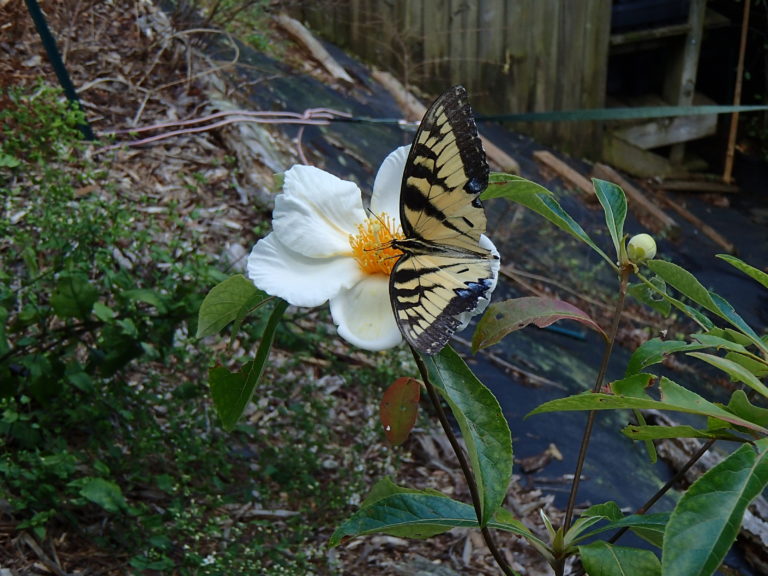One reason the Ben Franklin tree is grown is because it is attractive: fragrant, 3-inch flowers with delicate white petals and thick, bushy golden stamens, and foliage that is handsome, with outstanding fall coloration (red, purple, orange). But mostly it is grown because it is rare and has a great story. In colonial days, John Bartram, the king’s official botanist for the colonies, came across a stand of this small, ornamental tree on the banks of the Altamaha River in Georgia. He and one of his sons, William, grew this tree in their garden in Philadelphia (America’s first botanical garden), and named the tree after a friend of the family, Ben Franklin. The tree has been documented to occur naturally nowhere else than these few acres next to the river, and disappeared even from there in the early 19th century. So all of the living specimens of this species are descended from the collections of the Bartrams. “They” say the Ben Franklin tree is easier to grow in a pot than in soil, and happier in the north than in the south where it was native. It can be finicky, preferring well drained sandy soil with lots of irrigation in dry times, susceptible to root rot, but when it is happy it is happy and a treat to look at. Skinny if grown as a single stem, it is quite full and impressive when grown multi-stemmed, flowering from July into fall, even as the foliage is turning colorful. It is in the Theaceae, along with Camellias, Gordonia, and Stewartias.
NURSERY HOURS
Wednesday: 10-4 Thursday: 10-6 Friday-Saturday: 10-4 Sunday: 12-4
Franklinia alatamaha

Key Info
Scientific Name: Franklinia alatamaha W. Bartram ex Marshall Synonyms: Gordonia alatamaha, Gordonia pubescens
Common Names: Ben Franklin Tree, Franklinia, Franklintree, Mountain Bay
Family Names: Theaceae (Tea Family)
Plant Type: Tree / Shrub
Leaf Retention: Deciduous
Flower Color: White
Special Characteristics: habitat, Attracts bees, Attracts butterflies, Good fall color, Slow growing, Good wildlife cover
Additional Info
Habit: Franklinia can be grown as a single-stemmed small tree, or as a multi-stemmed shrub. The crown is rounded (pyramidal when young) with many stems originating near the base. The bark is showy, marked with prominent vertical white ridges. The texture is medium to dense. The root system is not strong, hence the need for irrigation and/or protection from direct sun in the afternoons in the South.
Height: 15' - 20'
Spread: 15' to 20'
Soil Conditions: Moist, acidic, organically rich, well-drained soils: sandy, sandy loam, medium loam.
Leaves: Alternately arranged leaves are simple, 6-8 inches long, obovate, with serrated margins, deep green above, pubescent below, turning strong colors in fall,
Flowers (or reproductive structures: Spherical flower buds open successively forming solitary, cup-shaped single-camellia-shaped flowers with 5 bright white translucent petals and many golden stamens
Fruit: Flowers are followed by small, woody capsules 1 inch in diameter with ten segments, each containing five seeds.
Natural Distribution: Extinct in the wild.
USDA Hardiness Zone: 5 to 8
USDA Wetland Indicator Status in NC: not available.
Pollination: No info on the internet. We'll have to watch!
Propagation: Franklinia is grown from seeds and also from cuttings taken in late summer or fall.
